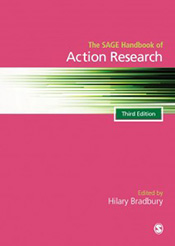 The Third Edition of the Sage Handbook of Action Research is out and includes a chapter I wrote on designerly ways. Here’s the introduction:
The Third Edition of the Sage Handbook of Action Research is out and includes a chapter I wrote on designerly ways. Here’s the introduction:
Consider design in the broad sense: design as ‘planning and patterning’ (Papanek, 1971: 3), design as ‘creat[ing] possibilities’ (Krippendorff, 2007), and design as ‘devis[ing] courses of action aimed at changing existing situations into preferred ones’ (Simon, 1969/1996: 111). In the broad sense of design, everyone designs, for design is fundamental to human nature. Archer (1979) and Cross (1982) described ‘designerly ways’ as complementary to those of the sciences and humanities. Such designerly ways – practical, creative solving and conjecturing – are illustrated in Nelson and Stolterman‘s (2012: 11) contention: ‘Humans did not discover fire – they designed it.’
‘Action research,’ described by Reason and Bradbury (2008: 11), ‘nearly always starts with a question of the kind, “how can we improve this situation?”’ In essence, then, the question that action research starts with is a question of design: the design of an inquiry or engagement, the design of an ‘intervention.’ Action research designs are characterized by cycles of ‘action and reflection, theory and practice, in participation with others’ (Reason and Bradbury, 2008: 4).
Advocates for design have also made a narrower claim for design, which is central to the concept of ‘design thinking’ (Buchanan, 1992; Brown, 2009). This claim is that specific understandings and repertoires cultivated through the study and performance of the design arts – the applied arts of graphic design, industrial design, textile and fashion design, digital design, architecture, engineering, and so on – are applicable to nontraditional contexts and situations, or applicable beyond the design of material and informational artifacts. This claim has garnered much attention and ignited much debate (NextD Journal, 2007). My own sense and annotation of this design debate is as follows: (1) the understandings and repertoires cultivated through the study and performance of the design arts can inform how one designs in nontraditional contexts and situations; (2) at the same time, designerly ways, broadly construed, need not arise from the experiences of the design arts; and (3) it is important to note ways in which the design arts’ traditional focus on material and informational artifacts may skew the development of designerly understandings and repertoires.
In this chapter, I describe designerly ways as practical skills for action research. My own standpoint is not that of someone trained in the design arts. Rather, I come to design as someone who has sought to create new possibilities and to change existing situations into preferred ones. More recently, as an instructor in applied systems thinking in a Master of Fine Arts program in Collaborative Design at Pacific Northwest College of Art, I have also come into closer dialogue with people in traditional arts and design fields. My perspective on design is therefore a broad one, as defined above, and a broadly systems-oriented one.
Silverman, H. 2015. Designerly Ways for Action Research. Pages 716-723 in H. Bradbury (Ed.) The Sage Handbook of Action Research, Third Edition. Sage Publications: Thousand Oaks, CA, USA.
http://actionresearchplus.com
Super-clear paper by @S4Pattern on “designerly ways for action research” http://t.co/MjErF8jRK7
— john thackara (@johnthackara) August 27, 2015

